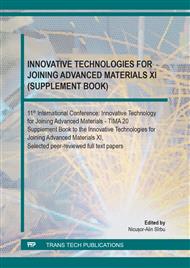p.3
p.9
p.17
p.25
p.35
p.47
p.55
p.67
Eutectic Microbonding of Composite Materials Using Microwave Technology
Abstract:
The paper aims to report researches in microbonding process of composite magnetic materials using as thermal source the heat produced in base materials by the conversion of the electromagnetic waves with high frequency into thermal energy. This technology can be applied by targeting the base materials with microwaves and taking into account that composite magnetic materials based on ferrites, present good absorbance and conversion properties of the microwaves into heat. For experimental research, the base materials were sintered sampled of raw products obtained from stoichiometric mixtures of 6Fe2O3 + BaCO3. The raw products were obtained by milling and alloying processes using planetary ball mills. The milling and alloying processes have been perfomed in dry environement for homogeneous mixtures and wet environment for mixtures obtained using mechanical alloying. In terms of eutectic alloys used for microbonding, there have been used lead free Sn96,5%+Ag3%+Cu0,5% with melting point around 2170 C. The microbonding process have been perfomed in two steps: first step was focused on prepairing the base materials by cleaning and deposition of eutectic alloys on their surfaces; the second step was the heating of the base materials in microwave field. A microwave generator with adjustable input power from 0 W to 6000 W with a WR340 waveguide have been used as thermal sources. The researches have shown that the base materials were bonded using less than 10 % of microwave power and the eutectic alloys reached the melting temperature în less than 3 seconds when the magnetron was set to full power. A matching load impedance automatic tuner up to 6000 W have been used for increasing the level of absorbed power from nicrowave generator to samples and decreasing the level of rejected power from composite magnetic material to microwave generator. The temperature have been measured using IR pyrometers with range measurement between 0 and 7000 C. The process can be succesfully applied to a large scale for small parts of electrical engines with permanent cermic magnets.
Info:
Periodical:
Pages:
17-23
Citation:
Online since:
June 2021
Keywords:
Price:
Сopyright:
© 2021 Trans Tech Publications Ltd. All Rights Reserved
Share:
Citation:


